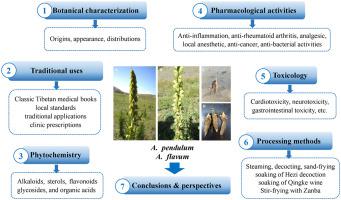Journal of Ethnopharmacology ( IF 4.8 ) Pub Date : 2022-03-22 , DOI: 10.1016/j.jep.2022.115216
Cong-Ying Li 1 , Zhen Zhou 1 , Tong Xu 1 , Nai-Yu Wang 2 , Ce Tang 1 , Xiao-Yan Tan 2 , Zi-Ge Feng 1 , Yi Zhang 1 , Yue Liu 1

|
Ethnopharmacological relevance
Composed of dried Aconitum pendulum and Aconitum flavum roots, Tiebangchui, is an important Tibetan medicine and has been traditionally and widely used as a remedy for cold and pain for thousands of years because of its extraordinary pharmacological activities. The toxicity and efficacy of Tiebangchui as a typical toxic traditional Tibetan medicine, are interdependent, and thus to make sure its safe use in clinics is also noteworthy.
Aim of the study
This review aims to document and summarize critical and comprehensive information about traditional uses, phytochemistry, pharmacology, toxicology and processing methods of Tiebangchui. Perspectives for possible future investigations have been discussed.
Materials and methods
Relevant information about Tiebangchui (A. pendulum and A. flavum) was collected from internationally recognized electronic scientific databases, such as Web of Science, PubMed, Science Direct, Springer Link, ACS, and CNKI. Then, classic Tibetan medical books, such as Four Medical Tantra, and Jing Zhu Materia Medica, and official drug standards were reviewed.
Results
A total of 95 chemical constituents have been isolated and identified from Tiebangchui, and most of them were diterpenoid alkaloids. These phytochemicals showed a wide range of pharmacological properties, such as anti-inflammation, anti-rheumatoid arthritis, analgesic, local anesthetic, anti-cancer and anti-bacterial activities. Hence, Tiebangchui is broadly used in hundreds of preparations to treat fever, arthritis, rheumatic arthralgia, traumatic injury, furuncle and swelling. Cardiotoxicity, neurotoxicity and gastrointestinal toxicity are the main toxic effects caused by the Aconitum alkaloids of Tiebangchui. Various processing methods, including steaming, decocting and sand-frying, and traditional Tibetan medicine processing methods, such as processing with Hezi decoction, Qingke wine and Zanba, are effective in attenuating toxicity while retaining efficacy.
Conclusions
The present review provides primary information of Tiebangchui, particularly for its traditional uses, botanical characteristics, phytochemicals, outstanding bioactivities and processing methods. However, studies that explored the in vivo pharmacokinetics and mechanism of Tiebangchui, as well as its quality markers, qualitative and quantitative analysis are still insufficient. Processing methods that attenuate toxicities, evaluations of efficacy, in vivo processes and biological effects, the mechanisms of processed products should be further explored.































 京公网安备 11010802027423号
京公网安备 11010802027423号